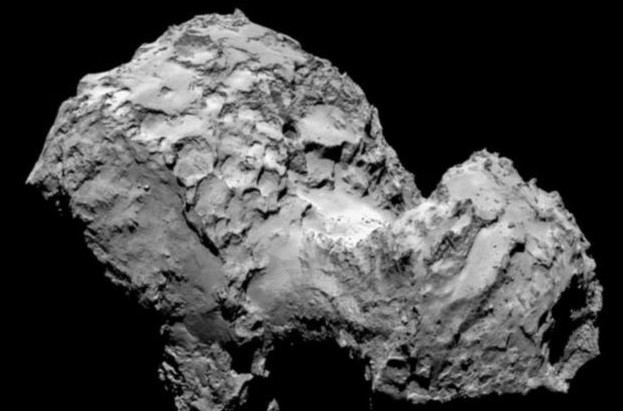European Space Agency's Rosetta Spacecraft Finds 'Human Face' on Comet 67P

The European Space Agency's Rosetta spacecraft has successfully reached the orbit of a speeding comet after a 10-year journey and has revealed the first close-up pictures of the object.
The first images sent from the probe, which is now in orbit within 62 miles of Comet 67P/Churyumov-Gerasimenko, have unearthed an unusual feature - a human-looking face.
First commented on by German Aerospace, the phenomenon was revealed to be an optical illusion. Yet news of the comet's "face" has been spreading on social media.
During the rendezvous with the comet, which is travelling at 34,000mph, Rosetta moved closer to its target while adjusting its speed in a series of complex manouvres.
"This arrival phase in fact is the most complex and exotic trajectory that we have ever seen," Jean-Yves Le Gall, president of the French Space Agency CNES, told the BBC.
When the probe reached the comet, the craft's caretakers tweeted "Hello, comet!" in 23 languages.
"After 10 years, five months and four days travelling towards our destination, looping around the Sun five times and clocking up 6.4 billion km, we are delighted to announce finally 'we are here'," said Jean-Jacques Dordain, director general of the European Space Agency (ESA).

"Europe's Rosetta is now the first spacecraft in history to rendezvous with a comet, a major highlight in exploring our origins. The discoveries can begin."
The spacecraft has become the first probe to ever orbit a comet and if all goes according to plan over the next few weeks, Rosetta will drop its robotic lander, Philae, on its surface in November.
Throughout August, Rosetta will fly around the comet in a triangular orbit to give scientists time to map the surface of the comet, as well as its shape and the strength of its gravitational field.
Rosetta was launched in March 2004. From June 2011 to January this year, the craft was put into deep-space hibernation for the coldest, most distant leg of its journey as it travelled over 400 miles from the Sun and headed into the outer Solar System.
Over the next few months, Rosetta will approach the comet to within 30km or so, in order to survey its rugged terrain and select an appropriate landing site for Philae.
It is hoped that these explorations will result in better understanding of comets and the early Solar System.
"Our first clear views of the comet have given us plenty to think about," said Matt Taylor, ESA's Rosetta project scientist.
"Is this double-lobed structure built from two separate comets that came together in the Solar System's history, or is it one comet that has eroded dramatically and asymmetrically over time? Rosetta, by design, is in the best place to study one of these unique objects.
"We're excited to get this milestone under our belts."
© Copyright IBTimes 2025. All rights reserved.






















